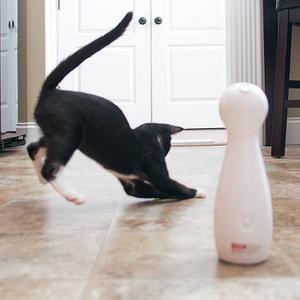It's great fun to watch cats play, but when kitten play goes overboard, what's a caring pet parent to do? Just as bored dogs target inappropriate items, a playful cat or kitten left alone can turn your house upside down.
My 18 year old cat Seren doesn't play much anymore, but she does watch two-year-old Karma-Kat play. He gallops up and down the stairs, un-makes the bed, and even knocks lamps off tables. I call him my delinquent kitty.
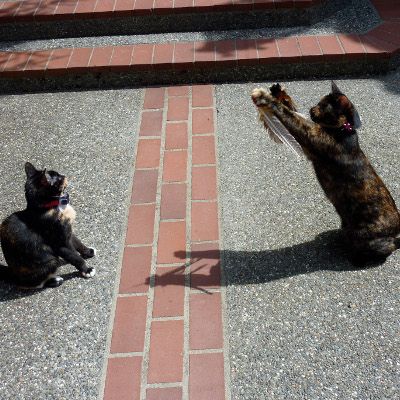 Why Cats Play
Why Cats Play
For kittens, play practices adult behaviors and lets the babies develop proper coordination skills while developing their muscles. It also teaches cause-and-effect, so that the baby recognizes that a paw-pushed object moves or that biting and clawing hurt.
No matter the age, play relieves stress and tension in a positive way. It also cements social bonds between cats, as well as promoting the human-animal bond. Playing increases confidence in less social cats and reduces fear in shy felines. Play also helps keep mature cats physically trim and mentally sharp.
You won't stop play, but you can redirect this normal behavior to something that's more appropriate. It's important to understand how cats they play so you can provide irresistible legal alternatives.
How Cats Play
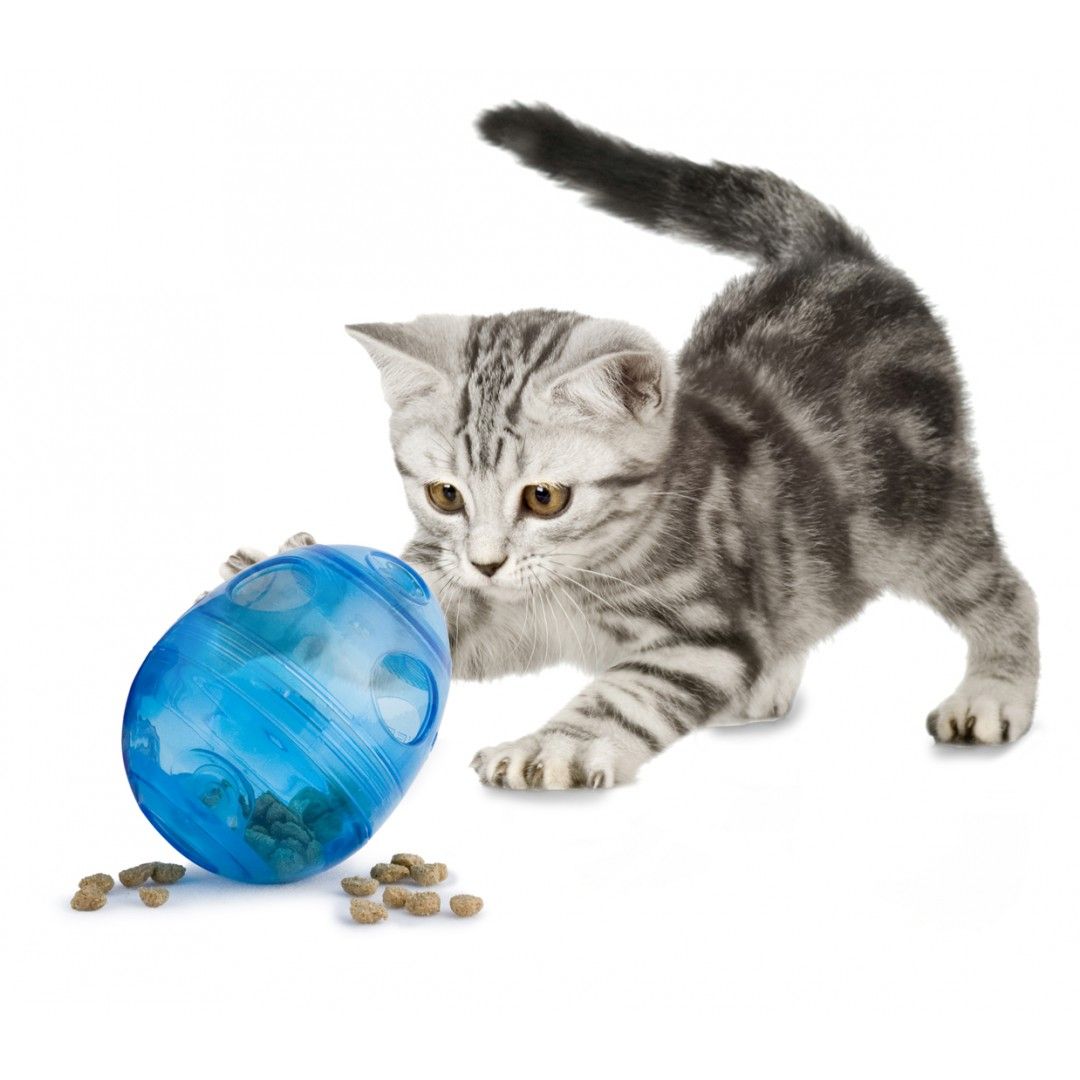 By 4 weeks of age, kittens practice four basic play techniques: pounce, swat, scoop and fight.
By 4 weeks of age, kittens practice four basic play techniques: pounce, swat, scoop and fight.
Play fighting first takes place when the kitten is on his back, belly-up, with paws waving. Feints at the back of a littermate's neck mimic the prey-bite used to kill prey (or a toy). Kittens also do a sideways tippy-toe maneuver with back arched high while they bounce and sidle around objects or other pets.
Once eye-paw coordination develops, kittens learn to pounce, swat and scoop objects and paw-punch each other. They take turns playing tag, execute wild leaps, and wrestle or box as they learn to inhibit tooth and claw or suffer the consequences.
Pet parents may be surprised to learn that watching also is part of play, as a prelude to stalking behavior. Even though elderly Seren no longer chases and pounces, her watchful attention tells me she's still engaged emotionally and mentally in feline kitty games.
Kinds of Play
 Social play is games with others. That can be playing tag with siblings or grabbing your toes. Social play reaches its peak in kittens aged 9-16 weeks, and then begins to decrease.
Social play is games with others. That can be playing tag with siblings or grabbing your toes. Social play reaches its peak in kittens aged 9-16 weeks, and then begins to decrease.
Object play is interaction with toys--and for cats, everything is a potential toy, including the find china breakables on your mantel. Movement and sound stimulates play behavior, and cats tend to react more readily to motion perpendicular to their line of sight.
Self-directed play includes tail chasing or pouncing on imaginary objects. This probably happens mostly as a replacement for social play when a play-partner isn't available.
Locomotory play simply means the cat is in motion. That can involve solo play of running and pouncing on imaginary targets or involve others.
5 Ways to Entertain Indoor Cats
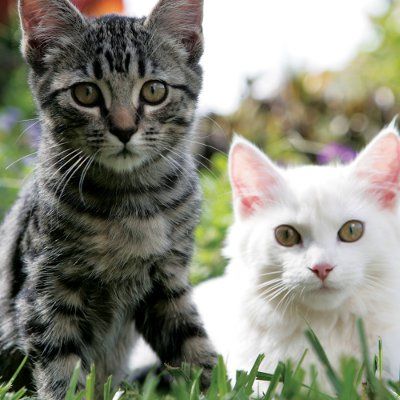 I'm a huge advocate of interactive play with your cats. Most of us cannot be with our cats all the time, though. Here are some ways to make sure your cat has something fun--and safe--to do when you can't supervise.
I'm a huge advocate of interactive play with your cats. Most of us cannot be with our cats all the time, though. Here are some ways to make sure your cat has something fun--and safe--to do when you can't supervise.
Adopt A Friend. Don't listen to those who say cats are loners. Most cats are social creatures who love having a friend, especially when pairs of youngsters are adopted together. A pair of cats entertain each other when you aren't there. They target each other instead of un-stuffing your sofa.
Offer Cheap Thrills. Cats don't care how much you spend. An empty paper bag or box provides hours of entertainment. Try leaving a Ping Pong ball inside the empty bathtub for paw-patting enjoyment. The tub keeps the cat from punting beneath the furniture, too. Choose light weight toys easy to bat around that make interesting noise. Extra cat trees and tunnels enrich the environment and keep the cat brain engaged. Offer fresh catnip to give the cat a legal high, so she'll sleep it off and leave your breakables alone.
Give Her Kitty TV. There are DVDs and "critter" channels available that provide cats with lots of visual fun. Most felines, though, prefer watching the real thing. Set up a bird bath and feeders near a favorite kitty lookout for hours of entertainment.
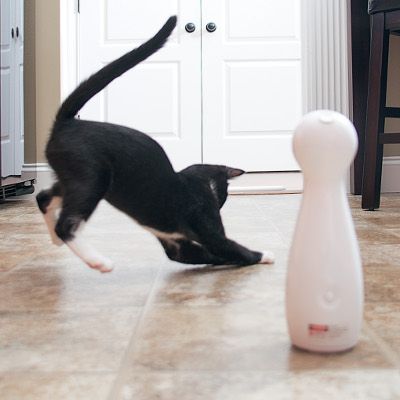 Provide Puzzle Toys. Feline puzzle toys filled with treats or one of the cat's meals provides entertainment, exercise, and brain stimulation to foil feline boredom. You can make a homemade puzzle using a clear empty water bottle with a bit of kibble inside. The cat rolls it around to shake out the munchies. My Karma-Kat, though, is a huge fan of the Twist And Treat toy for cats, that can be filled with dry munchies. The Egg-Cerciser Cat Toy is another great choice.
Provide Puzzle Toys. Feline puzzle toys filled with treats or one of the cat's meals provides entertainment, exercise, and brain stimulation to foil feline boredom. You can make a homemade puzzle using a clear empty water bottle with a bit of kibble inside. The cat rolls it around to shake out the munchies. My Karma-Kat, though, is a huge fan of the Twist And Treat toy for cats, that can be filled with dry munchies. The Egg-Cerciser Cat Toy is another great choice.
Automatic Toys. In addition to food rewards, cats relish motion and interesting noises to lure them to chase. Today, a wide variety of automatic toys are available, including the FroliCat products. These offer preprogrammed laser lights to chase (Bolt and Dart products, for example), or the FroliCat Flick that flips a string to chase. There's even a FroliCat Pounce toy with a mechanical mouse on a track that races about, hides, and teases cats into play.
Bottom line, cats and kittens play because it's FUN. Play is serious business for your cat and is a normal feline behavior. While some cats play more than others, all cats benefit from fun and games both physically and emotionally. Plan ahead when you must be gone, and reserve special toys for these times. That way your cat may even lobby for you to leave!



